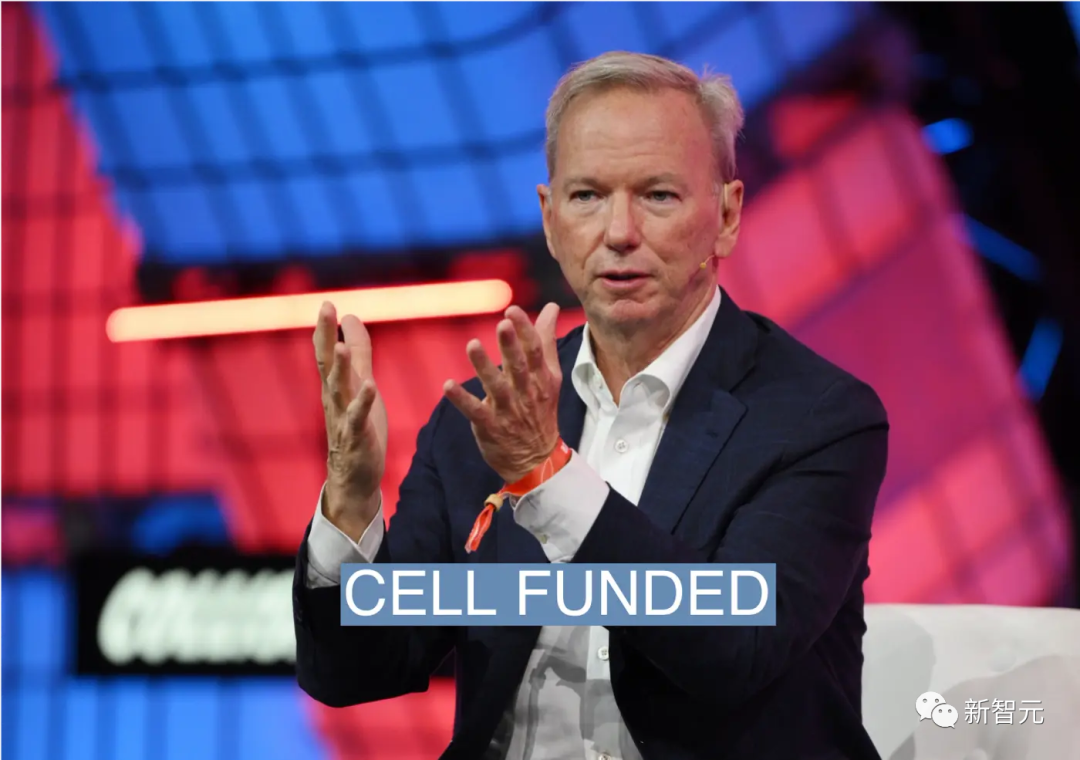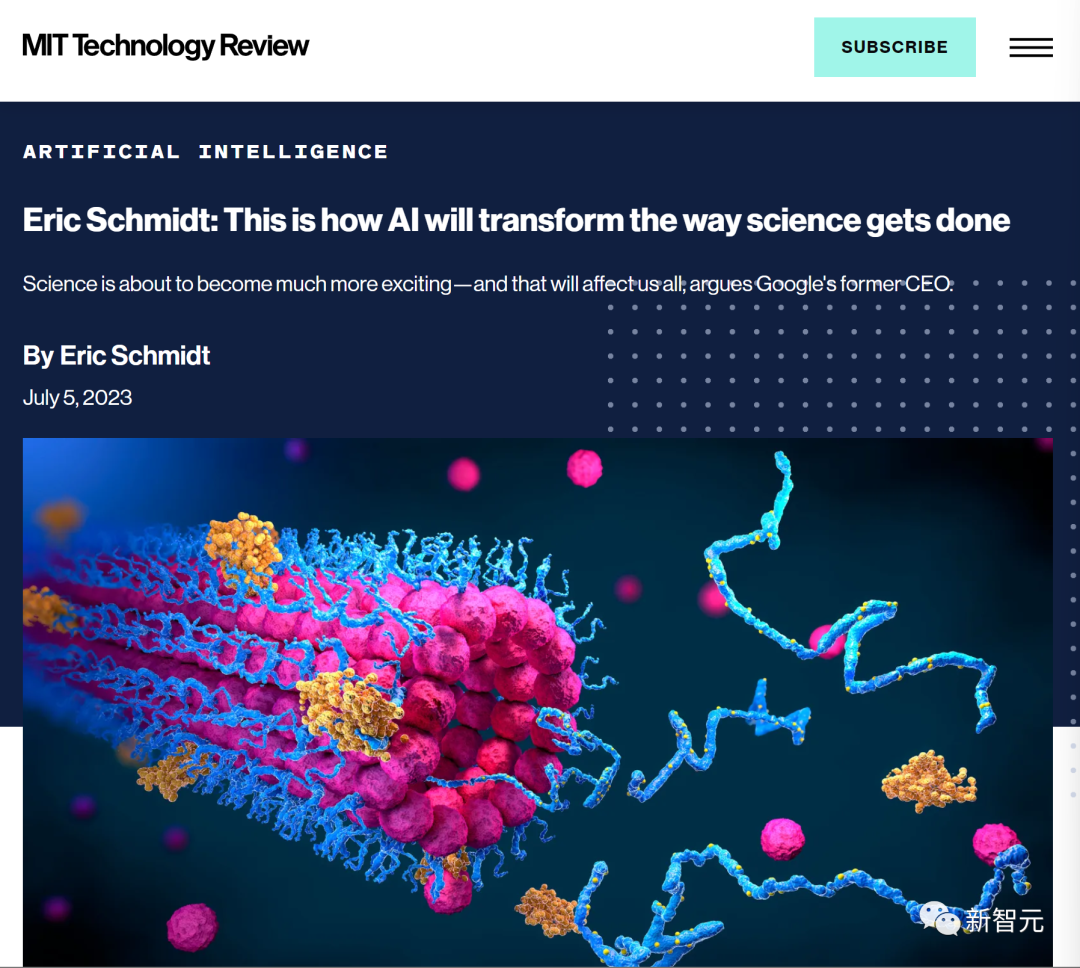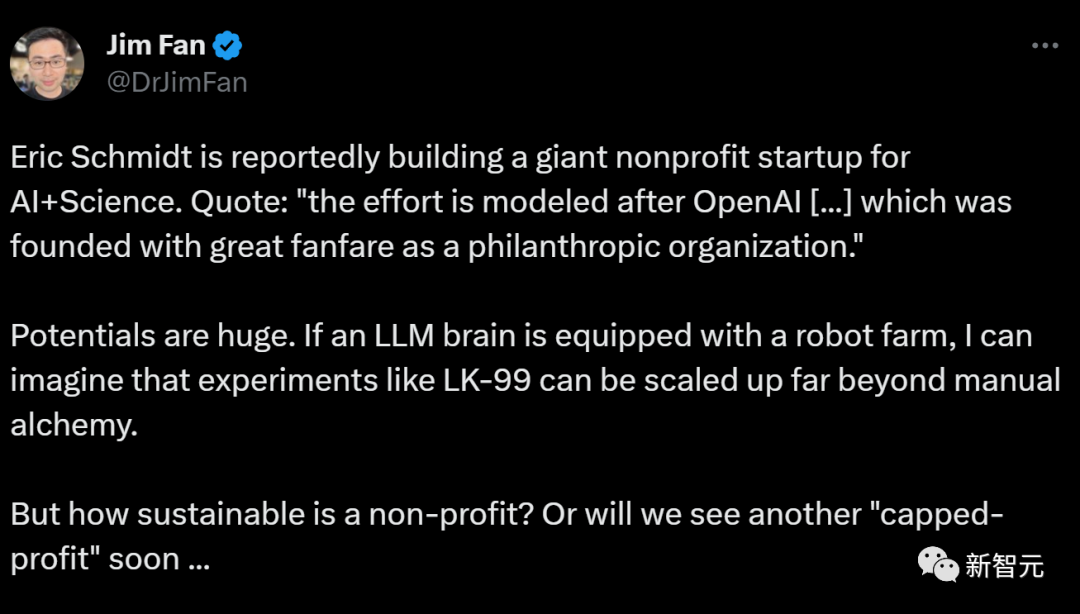 Technology peripherals
Technology peripherals
 AI
AI
 Former Google CEO launches AI+Science moonshot plan to achieve OpenAI's goals
Former Google CEO launches AI+Science moonshot plan to achieve OpenAI's goals
Former Google CEO launches AI+Science moonshot plan to achieve OpenAI's goals
Former Google CEO Eric Schmidt is launching a massive AI science non-profit startup aimed at using artificial intelligence to address challenges facing scientific research
 Picture
Picture
He invited two outstanding scientists to lead this non-profit initiative:
Francis Crick Institute Application Samuel Rodriguez, founder of the Biotechnology Laboratory, and Andrew White, a professor at the University of Rochester and a pioneer in the use of artificial intelligence in chemistry. They are all relatively young academic stars in their respective fields who have already achieved outstanding achievements
Schmidt, Rodriguez and White all believe that artificial intelligence will change the future of scientific research
In an article titled "How AI Will Change the Way Science is Done" published in "MIT Technology Review", Schmidt expressed his vision
With the advent of artificial intelligence, science will become more exciting and, in some ways, unrecognizable. The impacts of this shift will reach far beyond the confines of the laboratory, they will affect us all
 Pictures
Pictures
at On the other hand, Rodriques and White have put forward predictions and assumptions that artificial intelligence will subvert science in their own experimental websites or public speeches
Rodriques said: "We need a core AI A team of researchers and core scientists who will work together and employ rapid iteration cycles to build tools that leverage cutting-edge technologies and bring real value to scientists."
Jim ·Fan believes this company has great potential. If LLM and intelligent robots become the infrastructure of future scientific research, experiments like LK-99 will no longer remain at the level of manual alchemy
 Picture
Picture
According to people familiar with the matter, the work Schmidt is doing is based on OpenAI as a template, but the funding comes from Schmidt Futures, which Schmidt co-founded with his wife Wendy. Basically, the funds for the activities were paid by Schmidt personally
Jim also expressed concerns about whether Schmidt’s organization can continue
AI Science Moonshot
Determining the basis for forming scientific insights and theories is how to collect, transform and understand data
Among them, the collection of data and analysis are the basis of scientific understanding and discovery.
In the 1950s, the introduction of digital technology paved the way for the widespread use of computers in scientific research
Since 2010, The rise of deep learning enables artificial intelligence to provide valuable guidance by identifying scientifically relevant patterns from large data sets. This significantly expands the scope and ambition of the scientific discovery process
Scientific discovery is a multifaceted process involving several interrelated stages, including hypothesis formulation, experimental design, data collection and Analysis
Although there are differences in scientific practices and procedures at different stages of scientific research, artificial intelligence algorithms have the ability to span traditionally isolated disciplines
Artificial intelligence (AI) is increasingly used in the integration of massive data sets across disciplines and fields, precise measurements, experimental guidance, and exploration of data-compatible theoretical spaces, while also providing actionable and Reliable models and integration with scientific workflows
The application of AI can enhance the design and execution of scientific research. It can collect, visualize and process data by optimizing parameters and functions, automating procedures to explore a large number of candidate hypotheses to form theoretical perspectives, and generate hypotheses and estimate their uncertainties to make recommendations for relevant experiments
 Picture
Picture
Science in the AI Era
However, using artificial intelligence to conduct scientific research does not mean that it can be done casually
One of the biggest challenges is the huge hypothesis space in scientific questions. This makes systematic exploration unfeasible
In the field of biochemistry, it is estimated that the number of drug molecules that need to be explored is about 10 to the 60th power
While AI systems can revolutionize scientific workflows by speeding up processes and providing predictions with near-experimental accuracy
Obtaining reliably annotated datasets is a challenge for AI models This is a rather large project that may require a lot of time and resources for experiments and simulations
In recent developments, AlphaFold was developed by Google DeepMind and successfully solved a 50-year-old problem. Protein Folding Puzzle
Molecular system simulations of millions of particles16 powered by AI-powered AlphaFold demonstrate the potential of artificial intelligence in solving challenging scientific problems
One problem is that people’s opacity about the internal operation of AI will reduce trust in the prediction results and also limit its applicability in certain fields
For example, the output of the model must conform to real-life conditions before practical application. For example, human space exploration and areas that inform policymaking, such as climate science, etc.
Future Scientific Research
For AI majors Looking into the future, the demand for knowledge will be affected by two forces
First, one of the areas that will benefit from AI applications is autonomous driving. Secondly, the introduction of AI smart tools will enhance state-of-the-art technology and create new opportunities, such as applications in biological, chemical or physical processes, such as using AI to study nuclear fusion reactions, etc.
The composition of the future research team will change based on these two forces, including Al experts, software and hardware engineers, and new forms of cooperation involving all levels of government, educational institutions and enterprises
As state-of-the-art models continue to scale, energy consumption increases and computational costs become increasingly expensive. As a result, large technology companies are investing in computing infrastructure and cloud services, constantly pushing the limits of scale and efficiency. This means that both for-profit and non-academic organizations will use large-scale The computing infrastructure
# is necessary so that higher education institutions can better integrate multiple disciplines. In addition, academic institutions often possess unique historical databases and measurement techniques that may not exist elsewhere but are essential to Al Science
These complementary assets It will promote a new model of industry-university cooperation and have an impact on the selection of research questions
Reference:
https://www.php.cn /link/db261d4f615f0e982983be499e57ccda
The above is the detailed content of Former Google CEO launches AI+Science moonshot plan to achieve OpenAI's goals. For more information, please follow other related articles on the PHP Chinese website!

Hot AI Tools

Undresser.AI Undress
AI-powered app for creating realistic nude photos

AI Clothes Remover
Online AI tool for removing clothes from photos.

Undress AI Tool
Undress images for free

Clothoff.io
AI clothes remover

AI Hentai Generator
Generate AI Hentai for free.

Hot Article

Hot Tools

Notepad++7.3.1
Easy-to-use and free code editor

SublimeText3 Chinese version
Chinese version, very easy to use

Zend Studio 13.0.1
Powerful PHP integrated development environment

Dreamweaver CS6
Visual web development tools

SublimeText3 Mac version
God-level code editing software (SublimeText3)

Hot Topics
 1386
1386
 52
52
 Centos shutdown command line
Apr 14, 2025 pm 09:12 PM
Centos shutdown command line
Apr 14, 2025 pm 09:12 PM
The CentOS shutdown command is shutdown, and the syntax is shutdown [Options] Time [Information]. Options include: -h Stop the system immediately; -P Turn off the power after shutdown; -r restart; -t Waiting time. Times can be specified as immediate (now), minutes ( minutes), or a specific time (hh:mm). Added information can be displayed in system messages.
 How to check CentOS HDFS configuration
Apr 14, 2025 pm 07:21 PM
How to check CentOS HDFS configuration
Apr 14, 2025 pm 07:21 PM
Complete Guide to Checking HDFS Configuration in CentOS Systems This article will guide you how to effectively check the configuration and running status of HDFS on CentOS systems. The following steps will help you fully understand the setup and operation of HDFS. Verify Hadoop environment variable: First, make sure the Hadoop environment variable is set correctly. In the terminal, execute the following command to verify that Hadoop is installed and configured correctly: hadoopversion Check HDFS configuration file: The core configuration file of HDFS is located in the /etc/hadoop/conf/ directory, where core-site.xml and hdfs-site.xml are crucial. use
 What are the backup methods for GitLab on CentOS
Apr 14, 2025 pm 05:33 PM
What are the backup methods for GitLab on CentOS
Apr 14, 2025 pm 05:33 PM
Backup and Recovery Policy of GitLab under CentOS System In order to ensure data security and recoverability, GitLab on CentOS provides a variety of backup methods. This article will introduce several common backup methods, configuration parameters and recovery processes in detail to help you establish a complete GitLab backup and recovery strategy. 1. Manual backup Use the gitlab-rakegitlab:backup:create command to execute manual backup. This command backs up key information such as GitLab repository, database, users, user groups, keys, and permissions. The default backup file is stored in the /var/opt/gitlab/backups directory. You can modify /etc/gitlab
 Centos install mysql
Apr 14, 2025 pm 08:09 PM
Centos install mysql
Apr 14, 2025 pm 08:09 PM
Installing MySQL on CentOS involves the following steps: Adding the appropriate MySQL yum source. Execute the yum install mysql-server command to install the MySQL server. Use the mysql_secure_installation command to make security settings, such as setting the root user password. Customize the MySQL configuration file as needed. Tune MySQL parameters and optimize databases for performance.
 How is the GPU support for PyTorch on CentOS
Apr 14, 2025 pm 06:48 PM
How is the GPU support for PyTorch on CentOS
Apr 14, 2025 pm 06:48 PM
Enable PyTorch GPU acceleration on CentOS system requires the installation of CUDA, cuDNN and GPU versions of PyTorch. The following steps will guide you through the process: CUDA and cuDNN installation determine CUDA version compatibility: Use the nvidia-smi command to view the CUDA version supported by your NVIDIA graphics card. For example, your MX450 graphics card may support CUDA11.1 or higher. Download and install CUDAToolkit: Visit the official website of NVIDIACUDAToolkit and download and install the corresponding version according to the highest CUDA version supported by your graphics card. Install cuDNN library:
 Detailed explanation of docker principle
Apr 14, 2025 pm 11:57 PM
Detailed explanation of docker principle
Apr 14, 2025 pm 11:57 PM
Docker uses Linux kernel features to provide an efficient and isolated application running environment. Its working principle is as follows: 1. The mirror is used as a read-only template, which contains everything you need to run the application; 2. The Union File System (UnionFS) stacks multiple file systems, only storing the differences, saving space and speeding up; 3. The daemon manages the mirrors and containers, and the client uses them for interaction; 4. Namespaces and cgroups implement container isolation and resource limitations; 5. Multiple network modes support container interconnection. Only by understanding these core concepts can you better utilize Docker.
 How to choose a GitLab database in CentOS
Apr 14, 2025 pm 05:39 PM
How to choose a GitLab database in CentOS
Apr 14, 2025 pm 05:39 PM
When installing and configuring GitLab on a CentOS system, the choice of database is crucial. GitLab is compatible with multiple databases, but PostgreSQL and MySQL (or MariaDB) are most commonly used. This article analyzes database selection factors and provides detailed installation and configuration steps. Database Selection Guide When choosing a database, you need to consider the following factors: PostgreSQL: GitLab's default database is powerful, has high scalability, supports complex queries and transaction processing, and is suitable for large application scenarios. MySQL/MariaDB: a popular relational database widely used in Web applications, with stable and reliable performance. MongoDB:NoSQL database, specializes in
 How to view GitLab logs under CentOS
Apr 14, 2025 pm 06:18 PM
How to view GitLab logs under CentOS
Apr 14, 2025 pm 06:18 PM
A complete guide to viewing GitLab logs under CentOS system This article will guide you how to view various GitLab logs in CentOS system, including main logs, exception logs, and other related logs. Please note that the log file path may vary depending on the GitLab version and installation method. If the following path does not exist, please check the GitLab installation directory and configuration files. 1. View the main GitLab log Use the following command to view the main log file of the GitLabRails application: Command: sudocat/var/log/gitlab/gitlab-rails/production.log This command will display product



